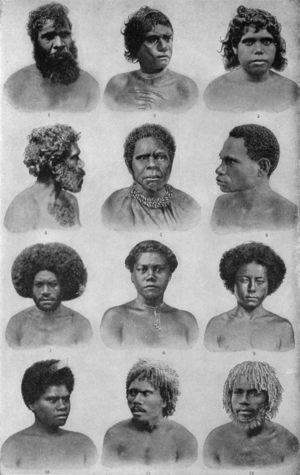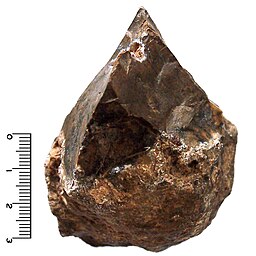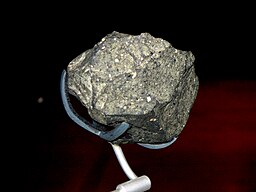Gallery of portraits of Aboriginal Australians (The New Student's Reference Work, 1914 edition, volume 1, p. 178.)
In physical anthropology, forensic anthropology and archaeogenetics, Australo-Melanesians (also Australasian, Australomelanesoid or Australoid) form a large group of populations indigenous to Maritime Southeast Asia and Oceania.
The group includes Papuans, Aboriginal Australians, Melanesians (mainly from Fiji, New Caledonia and Vanuatu) and the populations grouped as "Negrito" (the Andamanese, the Semang and Batek people, the Maniq people, the Aeta people, the Ati people, and various other ethnic groups in the Philippines).
The Vedda people in Sri Lanka and a number of dark-skinned tribal populations in the interior of the Indian subcontinent (mainly Dravidian-speaking groups and some Austroasiatic-speaking peoples, like Munda) are also suggested to belong to the Australoid group,
but there are controversies about this inclusion. A research involving
cranial morphology, made by Indian anthropologists, however, suggests
that the South Asian Indian populations have different cranial
characteristics from Australoid groups. This difference got possibly
strengthened in recent times due to the miscegenation with peoples of different origins.
A genetic study in 1985 suggested connections between tribal peoples of
Southern India, Sri Lanka and Negrito populations of the Philippines and Malaysia.
Nevertheless, a more recent study sustains that the Southern Indian
populations are not closely related to the classic Australo-Melanesian
groups.
The term "Australioid race" was introduced by Thomas Huxley in 1870 to refer to certain peoples indigenous to South and Southeast Asia and Oceania.
Terms associated with outdated notions of racial types, such as those
ending in "-oid" have come to be seen as potentially offensive
and related to scientific racism.
According to a large craniometric study (Raghavan and Bulbeck et al. 2013) the native populations of South Asia (India and Sri Lanka)
have distinct craniometric and anthropologic ancestry. Both southern
and northern groups are most similar to each other and have generally
closer affinities to various "Caucasoid" groups. The study further showed that the native South Asians (including the Vedda) form a distinct group and are not related to the "Australoid" group.
If there were an Australoid “substratum” component to Indians’ ancestry, we would expect some degree of craniometric similarity between Howells’ Southwest Pacific series and Indians. But in fact, the Southwest Pacific and Indian are craniometrically very distinct, falsifying any claim for an Australoid substratum in India.
— Pathmanathan Raghavan, David Bulbeck, Gayathiri Pathmanathan and Suresh Kanta Rathee, Indian Craniometric Variability and Affinities (2013)
Terminological history
Australians were marked as Negroid on the racial Meyers Konversations-Lexikon (1885-90)
The term "Australoid" was coined in ethnology in the mid 19th century,
describing tribes or populations "of the type of native Australians". In physical anthropology, Australoid is used for morphological features characteristic of Aboriginal Australians by Daniel John Cunningham in his Text-book of Anatomy (1902).
An Australioid (sic, with an additional -i-) racial group was first proposed by Thomas Huxley in an essay On the Geographical Distribution of the Chief Modifications of Mankind (1870), in which he divided humanity into four principal groups (Xanthochroic, Mongoloid, Negroid, and Australioid).
Huxley's original model included the native inhabitants of South Asia under the Australoid category.
Huxley further classified the Melanochroi (Peoples of the Mediterranean race) as a mixture of the Xanthochroi (northern Europeans) and Australioids.
Huxley (1870) described Australioids as dolichocephalic; their hair as usually silky, black and wavy or curly, with large, heavy jaws and prognathism, with skin of the color of chocolate and with irises that are dark brown or black.
The term "Proto-Australoid" was used by Roland Burrage Dixon in his Racial History of Man (1923).
In a 1962 publication, Australoid was described as one of the five major human races alongside Caucasoid, Mongoloid, Congoid and Capoid.
In The Origin of Races (1962), Carleton Coon attempted to refine such scientific racism
by introducing a system of five races with separate origins. Based on
such evidence as claiming Australoids had the largest, megadont teeth,
this group was assessed by Coon as being the most archaic and therefore
the most primitive and backward. Coon's methods and conclusions were
later discredited and show either a "poor understanding of human
cultural history and evolution or his use of ethnology for a racialist agenda."
Bellwood (1985) uses the terms "Australoid",
"Australomelanesoid" and "Australo-Melanesians" to describe the genetic
heritage of "the Southern Mongoloid populations of Indonesia and Malaysia".
Since the 1980s, anthropological terms in "-oid" have come to be
avoided in some disciplines, especially in the United States, where the
term Australo-Melanesian is now preferred.
In other areas, specifically in anthropological literature in India, the term Australoid continues to be preferred.
Distribution
Distribution of the races after the Pleistocene according to Carleton Coon (1962).
| Caucasoid race | |
| Congoid race | |
| Capoid race | |
| Mongoloid race | |
| Australoid race |
[DJS -- Isn't the classification of humans into "races" considered scientifically obsolete?]
Besides the Australian Aboriginals, Melanesians and Negritos, the "Australoid" category is often taken to include various tribes of India.
The inclusion of Indian tribes in the group is not well-defined, and is closely related to the question of the original peopling of India, and the possible shared ancestry between Indian and Australian populations of the Upper Paleolithic.
The American Journal of Physical Anthropology (1996, p. 382) by
American Association of Physical Anthropologists. Luigi Luca
Cavalli-Sforza, Paolo Menozzi and Alberto Piazza in their text, The History and Geography of Human Genes (1994, P. 241) all use the term.
Tee suggested Australoid ancestry of the original South Asian
populations has long remained an open question. It was embraced by
Indian anthropologists as emphasizing the deep antiquity of Indian
prehistory. Australoid hunter-gatherer and fisherman tribes of the
interior of India were identified with the Nishada Kingdom described in the Mahabharata. Panchanan Mitra (1923) following Vincenzo Giuffrida-Ruggeri (1913) recognizes a Pre-Dravidian Australo-Veddaic stratum in India. Alternatively, the Dravidians themselves have been claimed as originally of Australoid stock,
a view held by Biraja Sankar Guha among others.
South Indian tribes specifically described as having Australoid affinities include the Oraon, Munda, Santal, Bhil, Gondi, the Kadars of Kerala, the Kurumba and Irula of the Nilgiris,
the Paniyans of Malabar, the Uralis, Kannikars, Mithuvan and Chenchus.
but other Indian anthropologists of the post-colonial period, such as
S. P. Sharma (1971) and D. N. Majumdar (1946, 1965), have gone as far
as claiming Australoid ancestry, to a greater or lesser extent, for
almost all the castes and tribes of India. Newer Indian anthropology studies about cranial morphology do not support an Australoid ancestry in South Asian populations.
Physical features
Makassan man from Sulawesi, Indonesia. According to archaeologist Peter Bellwood, the vast majority of people in Indonesia and Malaysia, the region he calls the "clinal Mongoloid-Australoid zone", are "Southern Mongoloids" but have a high degree of Australoid admixture.
In physical anthropology, the Australo-Melanesian group is characterized primariliy by its characteristic dental morphology.
In Java, "Australo-Melanesian dentitions" are found in fossils until the
mid-Holocene (c. 5,000 years ago), but are replaced by
modern "Southern Mongoloid dentitions" (Sundadonty) in the Neolithic,
suggesting the displacement of the aboriginal Australo-Melanesian
population by the Austronesian expansion.
Genetics
Numerous studies of archaeogenetics performed during 2009–2016 have suggested that Eurasian populations can be derived from an early division of the non-African lineage into an eastern and a western clade lineage before around 40,000 years ago.
It has been argued, however, that this model of a primary split between eastern and western Eurasians is
invalid for Oceania and Southeast Asia.
The so-called "southern-route hypothesis" derives an Australasian
lineage, comprising Australians, New Guineans, and possibly Southeast
Asian Negritos, from an early out-of-Africa dispersal, forming an
ancestral lineage which split off the other non-African lineages prior
to the Eastern Eurasian vs. Western Eurasian split.
A number of 2016 studies have presented a refined model of Australasian ancestry.
Reviewing the evidence, Lipson and Reich (2017) present as best-fitting model a derivation of
the Australasian clade from the Eastern Eurasian clade at an early time, with sustantial Denisovan admixture (of the order of 4%) before the Ausralasian clade split into the Australian and the New Guinean lineages.
Pugach et al. (2013) find an ancestral association between
Aboriginal Australians, New Guineans and the Mamanwa Negritos, with an
estimated divergence time of at least 35,000 years, in support of the
"southern migration route" scenario.
In addition, the study finds evidence of gene flow between India and
Australia at a later time, an estimated 141 generations ago (i.e.
roughly 3,000 to 4,000 years ago), suggesting a possible late migration
wave to Australia.
A 2006 CFSL research article which assessed "3522 individuals belonging to 54 (23 belonging to the Austroasiatic, 18 to Dravidian, 7 to Tibeto-Burman and 24 to Indo-European
linguistic groups) endogamous Indian populations, representing all
major ethnic, linguistic and geographic groups" for genetic variations
to support such classifications found no conclusive evidence. It further
summed that "the absence of genetic markers to support the general
clustering of population groups based on ethnic, linguistic, geographic
or socio-cultural affiliations" undermines the broad groupings based on
such affiliations that exist in population genetic studies and forensic
databases.
Another study (Rosenbert et al.), analysing the whole genome of
worldwide populations, grouped the South Asians as own distinct group.
The study results suggest that there are 5 major human groups:
- Subsaharan-African (Negroid)
- West-Eurasian (Caucasoid)
- South-Asian ("Dravidoid")
- East-Asian (Mongoloid)
- Melanesian (Australoid)
Possible early presence in the Americas
A cast of the Luzia Woman's skull
A speculative theory of Walter Neves
in the 1990s proposes that an early Australoid population may have been
the earliest occupants of the New World. The theory was based on an
analysis of the Luzia Woman fossil found in Brazil, and found tentative academic support.
If this hypothesis is correct, it would mean that some Australoid groups continued the Great Coastal Migration beyond Southeast Asia, along the continental shelf north in East Asia and across the Bering land bridge, reaching the Americas by about 50,000 years ago.
Genetic evidence
In 2015, two major studies of the DNA of living and ancient people detect in modern Native Americans a trace of DNA related to that of native people from Australia and Melanesia. Australasian admixture in some living Native Americans, including those of the Aleutian Islands and the Surui people of Amazonian Brazil.
Evidence of Australasian admixture in Amazonian populations was found by Skoglund and Reich (2016).
Walter Neves and Mark Hubbe argue that these people descended
from an early wave of migration that was separate from the one that gave
rise to today’s Native Americans, and drew on a different source
population in Asia.
Morphology
Christy
Turner notes that "cranial analyses of some South American crania have
suggested that there might have been some early migration of
"Australoids."
However, Turner argues that cranial morphology suggests sinodonty in all the populations he has studied.
One of the earliest skulls discovered in the Americas by archaeologists is an Upper Paleolithic specimen named the Luzia Woman. According to Neves, Luzia's Paleo-Indian predecessors lived in South East Asia for tens of thousands of years, after migrating from Africa, and began arriving in the New World, as early as 15,000 years ago. Some anthropologists have hypothesized that Paleo-Indians migrated along the coast of East Asia and Beringia
in small watercraft, before or during the LGM.
Neves' conclusions have been challenged researchers who argued that the
cranio-facial variability could just be due to genetic drift and other
factors affecting cranio-facial plasticity in Native Americans.
In November 2018, scientists of the University of São Paulo and Harvard University released a study that contradicts the alleged Australo-Melanesian physical appearance of Luzia. Using DNA sequencing, the results showed that Luzia had Mongoloid features.
The bust of Luzia displaying African features was done in the 1990's.
"However, skull shape isn't a reliable marker of ancestrality or
geographic origin. Genetics is the best basis for this type of
inference," Strauss explained."The genetic results of the new study show
categorically that there was no significant connection between the
Lagoa Santa people and groups from Africa or Australia. So the
hypothesis that Luzia's people derived from a migratory wave prior to
the ancestors of today's Amerindians has been disproved. On the
contrary, the DNA shows that Luzia's people were entirely Amerindian."




















